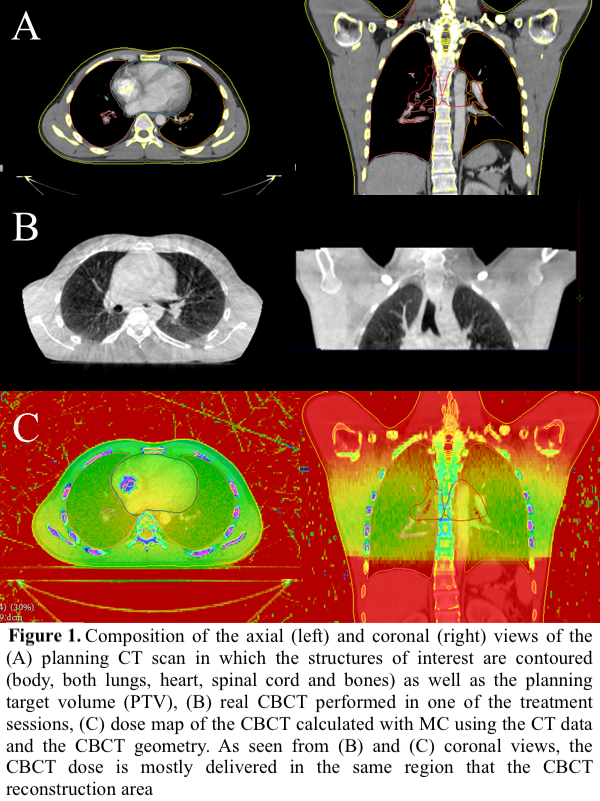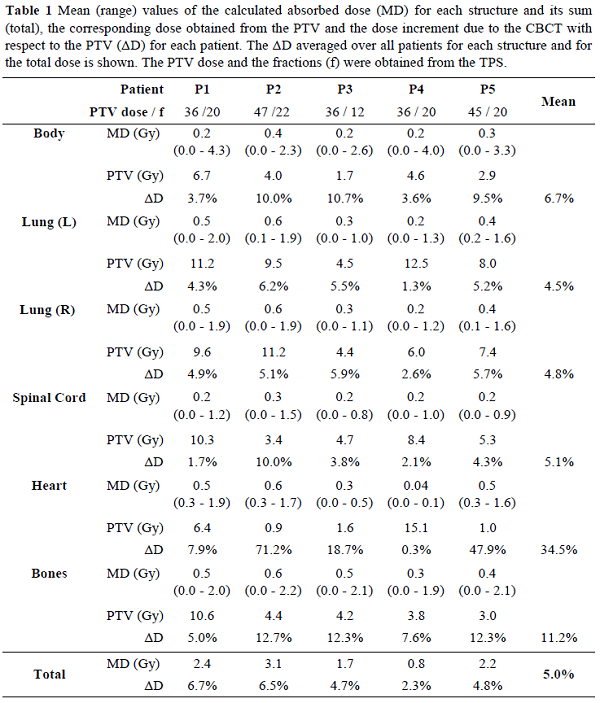CBCT dose distribution calculation with GATE Monte Carlo simulations for lymphoma patients
Mercedes Riveira-Martin,
Spain
PO-1815
Abstract
CBCT dose distribution calculation with GATE Monte Carlo simulations for lymphoma patients
Authors: Mercedes Riveira-Martin1, Isaac Sánchez-Díaz1, Ricardo Dorado Dorado2, Francisco Javier Salvador Gomez2, Benito Andrade Álvarez2, Manuel Salgado Fernández2, Victor Muñoz Garzón3, Virginia Ochagavía Galilea3, Iñigo Nieto Regueira3, Marios Myronakis4, Antonio López Medina2
1Galicia Sur Health Research Institute, Medical Physics, Vigo, Spain; 2Hospital do Meixoeiro, Galaria, SERGAS, Medical Physics and RP, Vigo, Spain; 3Hospital do Meixoeiro, Galaria, SERGAS, Radiation Oncology, Vigo, Spain; 4University of Crete, School of Medicine, Medical Physics, Heraklion, Crete, Greece
Show Affiliations
Hide Affiliations
Purpose or Objective
The council directive 2013/59/EURATOM requires ensuring that “new medical radiodiagnostic equipment producing ionising radiation has a device, or an equivalent means, informing the practitioner of relevant parameters for assessing the patient dose”. In contrast, commercial CBCT equipment provides poor information on the dose received by the patient. Although CBCT involves low patient doses compared to the prescribed dose of radiotherapy (RT), patients may undergo several images during treatment, which may lead to an increase in the absorbed dose and thus in the risk of developing radio-induced cancer.
Our aim is to calculate the organ-at-risk (OAR) dose distribution due to CBCT scans throughout the RT procedure in lymphoma patients. In addition, the H2020-funded SINFONIA project aims to predict the radiation risk associated with medical imaging, especially in young patients with lymphomas, whose survival is expected to be very high.
Material and Methods
Simulated CBCT dose maps were calculated with Monte Carlo (MC) methods using Geant4 GATE software with an Elekta’s Synergy model [1] on planning CT chest scans (Fig. 1A) from 5 lymphoma adult patients. The CBCT simulations (Fig. 1C) were performed with 1e9 particles. To calibrate the dose, the CTDIw was calculated on the simulation of a CTDI phantom (4.84e-8 mGy) and normalized to the CTDIw measured on the same phantom (21.1 mGy). The OARs were contoured in Aria (Varian Medical Systems, v 15.1). An open-source software (3D Slicer, v 5.0.3) was used to calculate the mean absorbed dose (MD) in each OAR. The dose absorbed by each organ due to the overall treatment was obtained from the TPS (Eclipse, v 15.6).

Results
For each patient, the mean values and the range of the total dose received by each structure were calculated considering all CBCTs (Table 1). These values were compared with the total dose delivered by the radiotherapy treatment (determined by the TPS) to calculate the relative increase with respect to this dose (ΔD) due to the CBCTs. As shown in Table 1, on average the dose received by CBCT in OARs increases the absorbed dose by 5% over the treatment dose. For body, lungs and spinal cord, increases of 4.5-6.7% were found, while for heart and bone this increase is 34.5% and 11.2%, respectively.

Conclusion
It is feasible to estimate the absorbed dose distribution received from a CBCT chest scan by MC simulations in GATE. It has been shown that performing CBCT simulations on planning CT previous to the treatment, may account for additional absorbed doses to the patient and for a possible reassessment of the treatment, especially for young patients.
Acknowledgement
This Project has received funding from the Euratom research and training programme: 2019-2020 under grant agreement No. 945196
References
[1] T Marchant, K Joshi. "Comprehensive Monte Carlo study of patient doses from cone-beam CT imaging in radiotherapy." Journal of Radiological Protection, 37 p13-30 (2017) (DOI: 10.1088/1361- 6498/37/1/13).